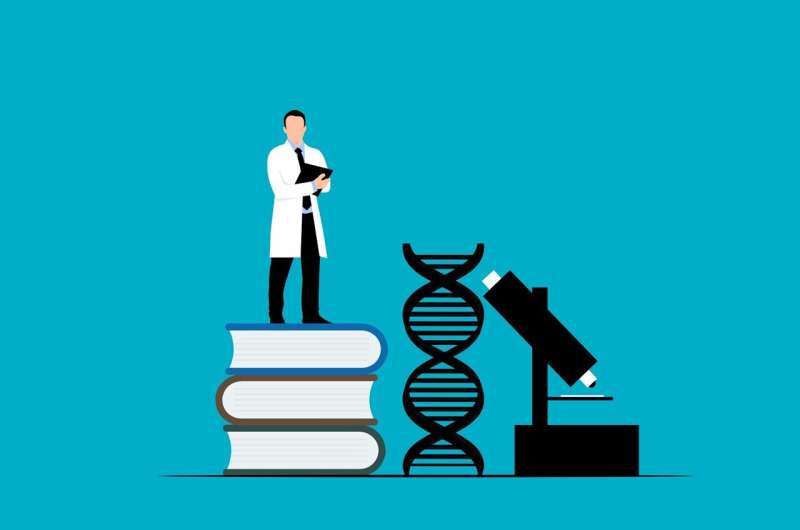Researchers discover one of the largest known bacteria-to-animal gene transfers inside a fruit fly

A fruit fly genome is not a just made up of fruit fly DNA—at least for one fruit fly species. New research from the University of Maryland School of Medicine's (UMSOM) Institute for Genome Sciences (IGS) shows that one fruit fly species contains whole genomes of a kind of bacteria, making this finding the largest bacteria-to-animal transfer of genetic material ever discovered. The new research also sheds light on how this happens.
The IGS researchers, led by Julie Dunning Hotopp, Ph.D., Professor of Microbiology and Immunology at UMSOM and IGS, used new genetic long-read sequencing technology to show how genes from the bacteria Wolbachia incorporated themselves into the fly genome up to 8,000 years ago.
The researchers say their findings show that unlike Darwin's finches or Mendel's peas, genetic variation isn't always small, incremental, and predictable.
Scientist Barbara McClintock first identified "jumping genes" in the 1940s like those that can move around within or transfer into other species genomes. However, researchers continue to discover their significance in evolution and health.
"We did not have the technology previously to unequivocally demonstrate these genomes-inside-genomes showing such extensive lateral gene transfer from the bacteria to the fly," explained Dr. Dunning Hotopp. "We used state-of-the-art long-read genetic sequencing to make this important discovery."
The new research has been published in the June issue of Current Biology.
In the past, researchers had to break DNA into short pieces in order to sequence it. Then they needed to assemble them, like a jigsaw puzzle, to look at a gene or section of DNA. Long-read sequencing, however, allows for sequences more than 100,000 DNA letters, turning a million-piece jigsaw puzzle into one made for toddlers.
In addition to the long reads, the researchers validated junctions between integrated bacteria genes and the host fruit fly genome. To determine if the bacteria genes were functional and not just DNA fossils, the researchers sequenced the RNA from fruit flies specifically looking for copies of RNA that were created from templates of the inserted bacterial DNA. They showed the bacteria genes were encoded into RNA and were edited and rearranged into newly modified sequences indicating that the genetic material is functional.
An analysis of these unique sequences revealed that the bacteria DNA integrated into the fruit fly genome in the last 8,000 years—exclusively within chromosome 4—expanding the chromosome size by making up about 20 percent chromosome 4. Whole bacterial genome integration supports a DNA-based rather than an RNA-based mechanism of integration.
Dr. Dunning Hotopp and colleagues found a full bacterial genome of the common bacteria Wolbachia transferred into the genome of the fruit fly Drosophila ananassae. They also found nearly a complete second genome and much more with almost 10 copies of some bacterial genome regions.
"There always have been some skeptics about lateral gene transfer, but our research clearly demonstrates for the first time the mechanism of integration of Wolbachia DNA into this fruit fly's genome," Dr. Dunning Hotopp said.
"This new research shows basic science at its best," said Dean E. Albert Reece, MD, Ph.D., MBA, who is also Executive Vice President for Medical Affairs, UM Baltimore, the John Z. and Akiko K. Bowers Distinguished Professor, and Dean, University of Maryland School of Medicine. "It will make a contribution to our understanding of evolution and may even prove to help us understand how microbes contribute to human health."
Wolbachia is an intracellular bacteria that infects numerous types of insects. Wolbachia transmits its genes maternally through female egg cells. Some research has showed that these infections are more mutualistic than parasitic, giving insects advantages, such as resistance to certain viruses.
Sequenced just three years before the human genome, fruit flies have long been used in genomic research because of the abundance of common fly-human genetic similarities. In fact, 75 percent of genes causing human disease can also be found in the fruit fly.
More information: Eric S. Tvedte et al, Accumulation of endosymbiont genomes in an insect autosome followed by endosymbiont replacement, Current Biology (2022). DOI: 10.1016/j.cub.2022.05.024
Journal information: Current Biology
Provided by University of Maryland School of Medicine





















